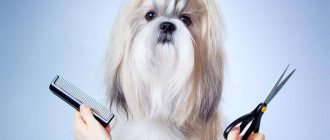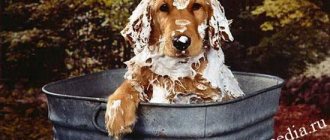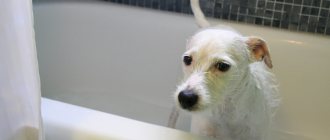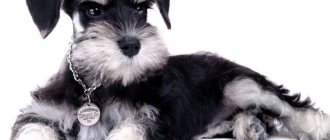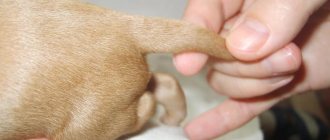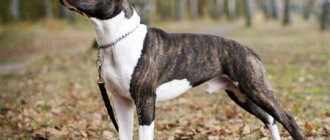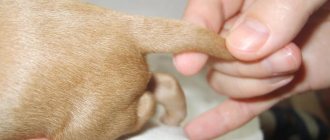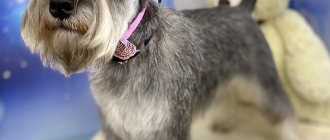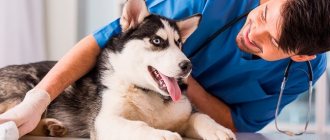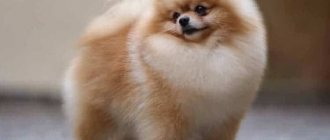To maintain a neat appearance of the animal, dogs periodically need to do trimming - this is plucking out dead remnants of fur. The coat of any dog is unique, but according to the general classification, all breeds can be divided into three types: wire-haired, short-haired and long-haired. The first type does not have a natural molting process.
The need for trimming for a dog
The extent to which it is necessary to remove the old coat can be determined by understanding its structure. In dogs, especially hunting breeds, during the process of evolution, the fur was divided into two layers. The lower one, adjacent to the skin, is soft and thick, protects from cold, parasites, and moisture. External - forms a kind of shell that reflects the attacks of winds, sharp branches and opponents.
Since pets are not exposed to aggressive environmental influences, the outer coat remains intact. Over time, it rolls down and turns into a dense, airtight cocoon. If the animal is not trimmed, after a few weeks diaper rash begins to appear on the skin, redness, itching and irritation occur, and infectious diseases caused by pathogenic flora develop.
With proper care, the dog's coat becomes clean and acquires a healthy, shiny appearance. Blood circulation in the skin improves, positively affecting all body systems and the pet’s mood.
Useful tips
Finally, you should pay attention to the following tips that will help the pet and its owner survive trimming with dignity:
- the first procedure will have to be carried out in stages, allowing the animal to rest from new sensations;
- manifestations of nervousness and dissatisfaction on the part of the pet should not be ignored; it is better to distract the dog from this state, for example, with a massage; after some time you can continue the procedure;
- There is no need to bathe before trimming; clean fur becomes smooth and silky, making it more difficult to remove;
- After trimming, the dog should be rinsed well with warm water, which will remove any remaining old hair and prevent the development of skin irritation.
- If trimming is carried out in the cold season, then the dog will have to be dressed for walks.
In the next video you can watch how to properly trim a fox terrier.
Haircut or trimming: what are the differences?
Proper care of an animal's coat is practiced mainly by breeders of champion dogs who take part in exhibitions. Other owners believe that a haircut can get by. It's a delusion.
Cutting the hair at the base does not solve the problem, but makes it worse. The guard hair, which makes up the bulk of the upper cover and needs trimming, consists of two parts, the lower one is thin and soft, the upper one is dense and hard. Shaving off the top leaves a thin root structure that continues to grow.
Over time, dogs that are clipped lose their coat quality. Growing hair looks like fluff, gets dirty faster and becomes tangled. After cutting, the hair structure is not restored. With proper care, that is, by contacting a groomer, it is possible to slightly change the top coat, but it is impossible to completely reverse the process.
Short-haired dogs of wire-haired breeds do not take prizes at exhibitions and, in general, differ from their counterparts in worse appearance.
It is recommended that hair care for cocker spaniels, Yorkies, schnauzers and other representatives of hunting breeds be left to specialists from the first days the animals live in the house.
It is important to understand that cutting is a cosmetic procedure, and plucking is a hygienic procedure.
What is it, who needs it and why?
Some breeds have very different coats from most other dogs. Its quality, structure and growth characteristics require completely different care. A special procedure for removing dead hair in dogs is called trimming.
Hard wool does not shed like any other, does not fall off and is not combed out. Lost coarse guard hairs become entangled in the undercoat and thick coat of new hair. Because of this, dense, matted areas of fur are formed, under which microorganisms and parasites develop, and inflammation occurs. Therefore, it is necessary to get rid of them regularly and this has to be done manually. Dog trimming is a technique of plucking out old fur using a special tool.
It is not recommended to cut dogs with this type of coat. At all. Since any haircut (with scissors or clippers) disrupts the structure of the hair. It becomes thin, soft, often brittle, and as it grows it becomes confused and falls off. Dark wool may partially lose its pigment and become gray or grey. In this case, only complete removal of the coat and subsequent long-term regrowth can help. This is a completely unacceptable option for a show-class pet.
Unlike haircuts, professional trimming for dogs does not harm the animal’s fur, but on the contrary, removing dead hair allows the skin to fully breathe and new and strong hair to grow. Renewing the coat normalizes thermoregulation, allowing the skin to cool in hot weather and not freeze in winter.
Breeds and frequency of pinching
Animals of wire-haired breeds and dogs with mixed hair types need to be plucked. This may include:
- fox terrier;
- Airedale Terrier;
- Welsh Terrier;
- Scottish Terrier;
- miniature schnauzer;
- Giant Schnauzer;
- miniature schnauzer;
- drathaara;
- wirehaired dachshund.
Puppies of different types of schnauzer breeds are subjected to the first plucking at the age of six months, dogs of large breeds - from 7-8 months.
Light trimming is best done three times a month, full trimming - 2 times annually. The best time for trimming is autumn and spring, when dogs begin to shed seasonally. If you plan to participate in competitions, you need to pluck your hair several months before the start of the exhibition. This does not apply only to schnauzers; their hair growth cycle lasts a little longer - up to six months. In this case, plucking can be done 4 months before the competition.
To find out for yourself whether the time has come for trimming, you need to lightly squeeze a small tuft of fur in your palm and gently pull. If there are hairs left in your hand, this indicates the need for this procedure. You can do this yourself or contact an experienced groomer.
Which breeds need trimming and how often?
Wire-haired dog breeds need trimming, such as:
- miniature schnauzer, miniature schnauzer, giant schnauzer;
- Fox Terrier, Airedale Terrier, Jack Russell, Lakeland Terrier;
- Brussels Griffon;
- Affen Pinscher.
The first trimming should be carried out on a puppy at the age of 4-6 months. This rids him of “baby” soft hair and allows him to grow a full, beautiful and thick coat. The procedure is repeated at least 2 times a year as a hygienic procedure. To maintain a neat and well-groomed appearance, the dog is trimmed once every 2-3 months. You can pluck stray hairs yourself once every 2-3 weeks. This way, the results of professional trimming will last longer. Full trimming can be done 2, maximum 3 times a year.
Exhibition trimming is carried out 1.5-2 months before the planned event. If your pet's fur grows slowly, it is better to do the procedure in advance, 2.5-3 months before the exhibition. In general, the frequency and intensity of plucking old fur depends on the individual characteristics of each breed and each pet in particular.
Trimming features
Trimming seems easy only when viewed from the outside. In fact, the procedure requires skill and experience. The cost in salons varies from 1800 to 3800 rubles, depending on the size of the pet. If you want to remove all the hair down to the skin, you pay an additional 2000 rubles on top of the tariff.
Some owners try to carry out the procedure themselves, which leads to bald spots in the dog's coat and an unkempt appearance of the dog.
Depending on the size of the animal and the skills of the groomer, various tools and devices are used during hair removal.
Cost of plucking
Since trimming requires some experience and knowledge in this matter, it is best to perform this procedure in a special grooming salon. The price in Moscow and Rostov varies between 1900−2300 rubles. for animals of small breeds and 2500−3800 rubles. for large dogs. If you require complete plucking of the coat down to bare skin, you will need to pay another 2,500 rubles.
Only an experienced dog breeder who knows all the anatomical features of the pet can perform this procedure at home. If a novice dog breeder takes on the job, the result may have negative consequences, which manifest themselves in the form of uneven processing of fur and bald spots.
Advice
Trimming in dogs is a long, painstaking and expensive procedure. The choice of a master must be approached responsibly and seriously. Consult with the breeder or dog lovers you know. The final result of plucking depends not only on the professionalism of the groomer, but also on his ability to establish contact with the “client”. A regular procedure should not turn into stress for the dog and an endless search for “his” master. You should not take risks and trim yourself if you do not have any experience. You risk causing pain to your pet and ruining its appearance.
Trim the dog with a clipper
To cut your hair with a clipper, you should read the instructions and cutting options in advance. First, the four-legged animal must be thoroughly washed to get rid of all the dirt in the fur. Next, you need to prepare your workplace. For this purpose, some kind of bedding is ideal, laid out within the reach of the necessary tools. After this you can start working.
All kinds of haircut options can be found in special magazines or even on the Internet. After completing the procedure, you should wash your pet again and, if necessary, adjust the haircut. If you use the machine correctly, you don’t have to worry about the safety of your four-legged dog, since it is not in danger of harm. The main thing to remember is that a dog trimmer needs:
- sharpening a dull knife blade;
- cleaning and lubricating the knife;
- monitoring the condition of the cutting heads.
It is worth understanding that each hair clipper has several replaceable knives. However, each manufacturer labels them differently. Let's say the Moser company offers a knife with a minimum height of 0.1 mm and a maximum of 9 mm.
There are two types of attachments that fit over knives: plastic and metal. Experts agree that knives are preferable to attachments, since the latter cope worse with wool. True, the master makes this choice independently.
For example, some specialists are additionally interested in the possibility of working with attachments such as a dog trimmer comb. In any case, a professional gives some advice when choosing equipment. Let's say a battery-powered machine requires an additional set of these same batteries so that an emergency does not lie in wait right during the procedure.
In principle, this is all the wisdom of choosing a trimmer, so the question of how to choose a trimmer for dogs should not drive you into a corner.
This is interesting: Alla Mikheeva with her husband
The choice of equipment for grooming animals is wide. As a rule, all of the specimens on the market can be found in a pet store. Grooming equipment is not considered expensive, but it is not possible to work without it in modern conditions. It is worth understanding that grooming is a complex service, where trimming is only a component of the entire process - hair cutting. At the same time, the appearance will be incomplete without the implementation of the entire range of services.
Types of trimming
The procedure has several divisions, depending on the method of execution, purpose and depth (degree of neglect of the animal).
Most dogs are trimmed by hand, carefully pulling out the outer hair. This process is called plating or rolling. Stripping involves the use of various devices.
The purpose of the procedure affects the frequency of execution. There are three main types of trimming purposes:
- Hygienic - carried out twice a year during molting periods. Most of the guard hair is removed. In preparation for the summer season, most of the undercoat is cut off, leaving 2-3 millimeters.
- Exhibition - involves preparing the animal for the event. During the process, all dead hair is carefully removed, leaving a young cover. The quality of the wool affects the jury's assessments, so this type of plucking is trusted only to specialists.
- Cosmetic - performed in the interval between molts. Shallow cleansing is preventive. With its help, they maintain the dog’s appearance and take care of skin health.
Nothing stands still; progress has also affected the field of animal care. If 20 years ago when trimming the dog was left bald, now the procedure has become more complicated and is divided into 2 types according to the depth of hair removal:
- Superficial or light - carried out monthly, removing up to 15% of the total amount of hair. If the procedure is skipped, then plucking up to 30% of the hair is performed once every 3 months. When working, they try not to touch living hairs, keeping the appearance of the animal unchanged.
- Deep or full - performed on neglected animals, when procedures have been missed for 4 months or more. All outer coat is removed by hand, the undercoat is clipped down to 2 mm with a machine. If, as a result of some process, the lower layer of the dog’s fur has changed color (for example, a black dog has become piebald), then plucking is done until the skin is bare.
Grooming is mandatory for all breeds, and the owners choose the time for performing the procedures independently, depending on the need and the general condition of the dog.
Is this a replacement for a haircut?
Some owners of wire-haired dog breeds believe that trimming and cutting are the same thing, without delving into the meaning of the procedures. These methods of processing wool have different purposes, so it cannot be replaced by cutting.
Trimming is a forced hygienic procedure that helps remove dead hairs, thereby ensuring the growth of new hairs with the correct structure.
During the cutting process, only the tops of the coarse guard hairs are removed down to the base, but the structure of the coat changes greatly. The cut hair with a thin base continues to grow and the animal eventually breaks into soft downy thin hair. Even a single haircut of a dog can lead to irreversible consequences and loss of the type of coat characteristic of the breed.
First grooming of miniature schnauzers
Up to 6-8 months, the coat of miniature schnauzers is more like fluff and does not require special care. Only after six months do they grow a hard awn, which requires grooming. This usually coincides with the appearance of molars. Therefore, the first grooming is carried out no earlier than the puppy has finished changing his fangs.
For the first time, grooming is carried out in the warm season. All manipulations are carried out only with dead hairs. Touching the young spine will frighten the dog and cause him pain. Therefore, if the pet’s “fur coat” is too soft, it is better to postpone the first grooming until 10 months of age.
It is better to entrust the first trimming of a puppy to a professional and learn from him the intricacies of the procedure.
Trimming miniature schnauzers is carried out using a clipper or scissors, removing dead hair from the dog's body. On the remaining parts of the body, the hair is carefully trimmed. Subsequently, the procedure is repeated approximately once a quarter. The frequency of grooming depends on the rate of growth and coat color. Black miniatures with brown or gray undercoat are trimmed more often.
A few words about washing
We should not forget that not every pet shampoo is suitable for coarse wool. For wire-haired breeds, manufacturers offer, in particular, special pet shampoos, one of which was rated especially highly by both breeders and groomers. This is Elite Professional shampoo, designed taking into account the characteristics of the coarse hair of dogs. Initially, Elite Professional was developed for use in pet salons to prepare dogs for exhibitions. But the unique formulation of Elite Professional shampoo is such that its home use is quite within the capabilities of the owner of the gesture. The main thing is to follow 3 rules.
- The dog's fur should be completely wet, down to the skin. No area should remain dry. For dense, coarse coats this can be a problem, so look at how dogs are washed at a pet salon.
- The shampoo should be rinsed off completely so that not even a hint of foam remains. With dense wool this is not easy to do. Therefore, do not skimp on water.
- Balm should be chosen as carefully as shampoo. The wrong conditioner can make your pet's coat too heavy.
Mr. Tail recommends: tools and accessories for dog trimming
During their work, groomers use many tools and each case has its own special devices. Considering each of them, it is easy to understand that it is difficult to carry out the procedure correctly at home.
When trimming use:
| Tool | Purpose | |
| Table | Equipped with an anti-slip coating and complemented by a place for fixing the collar, it allows you to keep the animal in a safe position for it. | |
| Knife | fine-toothed | Used when pulling out the undercoat at the end of the procedure. |
| with average | Designed for work on the hull. | |
| with rough and rare | For processing guard wool, thick and coarse. | |
| Stone | Similar in structure to pumice, it is used to clean fur from dirt and remove hair at the final stage in young dogs and puppies. | |
| Stone knife | Made from sandstone and has a rough, rough surface. Safe to use, cannot injure the skin of the animal. Used for work on the ears, face, and neck area. | |
| Powder | A specially developed composition ensures better adhesion of the tool to the hair and promotes skin renewal. | |
| Fingercap | They are divided into reusable and disposable. Used to protect the technician from damage and infection during manual trimming. | |
| Pukhoderka | An auxiliary tool is used at the final stages to remove hair from the lower soft layer. | |
| Comb comb | Essential for paw hair care | |
| Trimmer | The procedure is completed and used for edging. | |
Such a variety of tools and its features of use are available only to masters. At home, it is almost impossible to perform trimming efficiently.
After treatment, the instruments are cleaned mechanically, particles of dirt are removed, then washed with water and special disinfectant solutions.
Required Tools
To create a home salon, you will need professional tools. Most often, groomers use products from American, Belgian and Italian brands. The high price of the equipment is explained by their quality and ergonomics.
Working surface
For independent manipulations, you will have to purchase a folding table with anti-slip material. Thanks to the rough surface, the dog feels confident and less worried.
Some designs are equipped with a bracket that secures the animal by the collar. This table can be used not only for home grooming, but also at exhibitions.
Combs
To get the job done you will need several comb options. They all have different goals:
- Pukhoderka
. Essential for removing dead hair, styling during blow-drying and daily combing. Choose a tool with a small surface - 5x10 cm.
- Metal comb
with fine and large teeth
. Suitable for combing limbs and skirts. Unlike Furminator, it is safe for the undercoat. - Rake brush
. Stimulates blood flow and removes accumulated contaminants well.
All these combs are used in combination. This approach allows you to achieve a healthy and shiny coat.
Knives
Trimming knives are selected individually. You can start not only from skills, but also from the ability to use one or another hand. The models produced are designed not only for right-handers, but also for left-handers.
The main task of this tool is to carefully pluck the hair without cutting it. To do this, the steel blade is dulled. Knives are produced in 4 varieties:
- face – used to work with the muzzle;
- coarse – suitable for working with large dogs with thick or heavily overgrown fur coats;
- medium – used for processing and shaping the body;
- fine and extra-fine – designed for final processing, working with undercoat and short hairs on the ears, neck and head.
Beginners only need two knives: with fine and medium teeth. The first is suitable for more sensitive areas, and the second is for working with a large part of the body.
Powder and stone
Before manipulation, the animal is treated with a special powder. It exfoliates dead particles, eliminates slipping and normalizes grip. Instead, it is acceptable to use grooming crayons or baby powder.
Trimming a puppy is not complete without trimming stones. They act similarly to knives, but are used at the very end. Thanks to the porous and loose structure of the stone, which resembles pumice, all dirt and remaining hairs are carefully removed from the body.
Fingertips
Externally, the fingertip resembles a thimble and is used for similar purposes. It is necessary to protect against damage and prevent the formation of calluses. Its textured surface provides a smoother grip when hand-cut. For frequent manipulations, reusable silicone products are suitable.
Care products
Upon completion, the animal is washed with a veterinary hypoallergenic shampoo designed for wire-haired breeds. For easier combing, use balms. If irritation occurs after plucking, the skin is lubricated with baby cream, oils, Miramistin or Chlorhexidine.
How to work with a furminator?
The Furminator is a special tool for combing dogs and cats. It consists of a handle with a comb-shaped blade attached to it. This is the most effective method for removing dead undercoat. It does not damage the guard hairs during shedding. When combing with a furminator, the teeth grab the hair and pull it out, leaving the undercoat behind. Only dry hair should be combed. There is no need to apply pressure when working with the device.
Application in production
Pork trimming serves as a raw material for the production of various types of sausages, sausages, semi-finished products, sausages, and cutlets. Absolutely all enterprises use trimming in the production of semi-finished products. This significantly saves time, money, labor and, of course, significantly increases profits and production.
Most of the resulting raw materials are used for the production of minced meat and boiled sausage. Naturally, before going on sale, products undergo heat treatment. Trimming with a leaner meat content, for example 80/20 or 70/30, is used in the production of sausages, sausages or sausages. Trimming 50/50, with a high content of fatty meat, is used for preparing everyone’s favorite jellied meat or minced meat.
It turns out that pork trimming is a raw material for the production of semi-finished products, which, before becoming suitable for food, goes through several stages of processing. It is used only in large-scale production, but is not suitable for human consumption.
Work algorithm
The process begins by preparing the animal's fur. Owners are not recommended to wash their dog the day before. Dirt and dust allow for better grip on the tool.
Masters comb the animals with a slicker brush. Then the tangles are removed and separated manually using oils. Scissors are used in extreme cases, when hairballs cannot be processed.
Trimming takes place in 3 stages:
- First, take the tool and pluck the hair, pressing it between the working surface and the thumb. The choice of device depends on the depth of the procedure and the quality of the coat. The process starts from the back of the animal's head and moves towards the tail.
- With well-honed sharp jerks, the craftsmen pull out the wool in the direction of its growth. This is completely painless for the pet; some of them fall asleep during the lengthy procedure. Treatment of the armpits, muzzle, and thighs, that is, the most sensitive areas of the body, causes slight discomfort.
- The sequence of treatment is as follows: first clean the sides, then the back and then move on to the delicate areas.
No matter how long the trimming lasts, you cannot leave the process for the next few days. It is recommended to take breaks of 15-20 minutes so that the animal calms down and continue working until its logical conclusion.
After finishing plucking, wash your hands thoroughly and treat the used tool.
How to trim a dog correctly
The trimming process can be called an art, however, it is also subject to certain rules. The cutting process begins from the withers, after which the master moves along the back, neck, followed by emphasizing the hips and sides. The wool is removed in the direction of growth, separating small strands.
It is important not to pull the fur upward. In this case, you should act firmly and decisively. For certain dogs with extremely coarse hair, even the head needs to be trimmed. At the same time, you can speed up the process by dealing with the undercoat using a cutting machine.
True, this method has some disadvantages: the undercoat is dense, therefore, as soon as it begins to outgrow, it mixes with the guard hair. If the undercoat is always cut on time, the “shell” characteristic of the pet is lost. Dead hair remains, which can easily lead to severe irritation.
Upon completion of the procedure, the undercoat is tightly packed and acquires elasticity even to the touch. Proper trimming of, say, a fox terrier involves only plucking the fur; there is no need to resort to thinning scissors. A number of craftsmen work in this mode on principle, believing that only by pinching the ideal shape is obtained.
Scissors help
The use of scissors is justified only when cutting hair between the pads of the limbs; the rest is done with a trimming knife. However, today there are not so many principled masters who meet all the canons of trimming. The highest aerobatics for a trimming specialist is considered “manual” trimming, which is a long and labor-intensive process based solely on manual labor - with fingers, without special equipment.
You can take your hat off to such people, as this is comparable to a feat. There are still reasons for this madness: the hair will not break off, and the dog will simply look gorgeous.
Secondly, this trimming technique is comparable only to dog massage. The majority of groomers tend to use scissors and clippers, greatly reducing the time they spend working with the dog, which is sometimes beneficial even for the owner himself. Often you don’t have to bother at all and trim individual parts of the body, the torso or paws.
A wirehaired dog gets a haircut at the end of his professional career, with the arrival of retirement age. The principle of “exclusively trimming” should be applied only to show stars, although in most countries animals are constantly trimmed.
Trimmed wool becomes softer and, therefore, gets dirty faster. At times, after machine shearing, especially when the coat is naturally soft, it is more noticeable. The wool changes its own structure due to the fact that during the cutting process, the scissors do not injure the hair root, leaving only a soft and thin hair part.
In addition, in the case of regular cutting, the ratio of undercoat to hair changes. A couple of procedures may well ruin the coat, up to the need to restore it to its original state, which lasts months, or even years.
Benefit
Some owners confuse trimming with cutting, although these are completely different procedures. When coarse hairs are systematically cut with a clipper or scissors, the hair becomes dull, thinner, thinner, and becomes soft. After trimming, nothing like this happens: instead of the removed ones, new hairs of a similar structure and density grow. The quality of the hair not only does not deteriorate, but on the contrary, it improves.
Advantages and benefits for the pet:
- the procedure accelerates blood circulation, which has a beneficial effect on the growth of new hair;
- owners do not need to comb their pet every day, and it still looks well-groomed;
- timely removal of dead hair allows the skin to breathe, minimizes the risk of parasite proliferation and the development of infectious and fungal diseases.
Why is it needed?
Trimming is a kind of artificial shedding. Since this process is weakly expressed in wire-haired dog breeds, dead hairs must be plucked manually or using special tools.
If this important hygienic procedure is not carried out, the top layer of the animal's coat and undercoat becomes clogged with dead guard hair. Dead hairs still in the hair follicle prevent the growth of new healthy hairs.
The fallen awn falls off and becomes tangled, disrupting the natural circulation of air and moisture, creating a favorable environment for the development of fungal infections and the proliferation of parasites.
What is dog grooming?
Grooming rules
It is very important to brush your dog daily, and only in the direction of hair growth. Carefully work out areas with tangles. It is advisable to spray the wool with conditioner before the procedure. Then combing will be easier. The brush should be wide and not sharp.
Intimate places are also treated monthly. Using scissors, carefully trim the fur around the anus. Sticking hairs in the ears should be plucked out. Don't forget about the claws. They need to be cut carefully, since blood vessels run through the center of the claw. If you bite off more, blood will bleed and the dog will be in pain.
Listen to the recommendations of experts, and your beloved miniature schnauzer will be the healthiest and most beautiful dog.
How does the process work?
It is better to entrust the first procedure to a professional groomer. After carefully studying the work of the master, as well as receiving the groomer’s recommendations, you can treat the dog yourself. The algorithm for plucking hairs is simple, but such labor-intensive work requires patience and some preparation.
Before trimming a pet at home, first of all, it is necessary to prepare a workplace (table, cabinet) and tools. The pet does not need to be bathed before the procedure.
Algorithm of actions:
Step 1. put the dog on the table;
Step 2. Carefully comb the pet’s body along the hair growth path with a slicker brush and a sparse comb;
Step 3. You need to carefully separate the tangles with your fingers and try to comb them with a flat comb;
Step 4. It is better to start plucking hairs from the back of the head, or from the back, gradually moving towards the tail;
Step 5. if the groomer plucks the hairs manually, a small strand should be held with the index finger and thumb, then removed with a slight tug in the direction of hair growth;
Step 6. if plucking the guard hair is carried out using a knife, in this case the strand should be picked up with a tool held in your hand, and fixed with your thumb (with the fingers of your free hand you need to hold the skin next to the area being treated) and make a sharp jerk;
Step 7. After treating the back and sides, you should start plucking the hairs on the hips and shoulder blades.
It is better to pluck dead hairs on your pet's head manually, without using a knife, after combing your pet's head with a comb. You need to carefully remove dead hairs on the face and head. After completing the hygienic stripping procedure, the pet must be bathed in warm water, and after drying, remove any protruding hairs manually or with tweezers.
Examples before and after:
Video:


